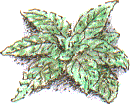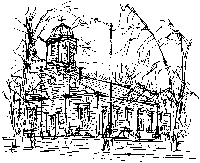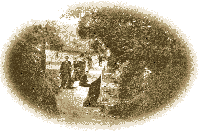 |
The Common ObjectsSaturday, 24th March 2001, West Yorkshire |
![]()
![]()
![]()
![]()
![]()
![]() This Month
Rocks
History
Workshop
Links
Home Page
This Month
Rocks
History
Workshop
Links
Home Page
![]()
 I'VE JUST been helping a neighbour with a computer problem.
I'VE JUST been helping a neighbour with a computer problem.'Oh, before you go, if you've got a minute,' he says, and takes an old box, like a miniature treasure chest, from the shelf, 'you might be interested to see this.'
 He unfolds a Victorian stereoscopic viewer. There are a stack of stereo pairs in the box, but it's one of a church he wants to show me. At first I don't recognise it, but I should, it's Thornes Church (1829-30) which I sketched for my book on Thornes Park. The view is taken from the summit of Lowe Hill (right). But it looks so different in the photograph, in a rural setting. None of the buildings that stand alongside it today are visible, in fact even the 99 arches railway viaduct in the background appears to be absent; if so it must have been taken before 1866.
He unfolds a Victorian stereoscopic viewer. There are a stack of stereo pairs in the box, but it's one of a church he wants to show me. At first I don't recognise it, but I should, it's Thornes Church (1829-30) which I sketched for my book on Thornes Park. The view is taken from the summit of Lowe Hill (right). But it looks so different in the photograph, in a rural setting. None of the buildings that stand alongside it today are visible, in fact even the 99 arches railway viaduct in the background appears to be absent; if so it must have been taken before 1866. The hedgerow and ditch in the foreground interest me. They were probably destroyed when summit of the hill was landscaped when the Victorian public park was laid out here. In the photograph they're plain to see. These earthworks may have been part of the remains of a temporary castle dating for the 12th century. The motte still tops the hill. In Victorian times, opposing armies of boys from Thornes and Wakefield used to meet annually to fight a 'king of the castle' contest for possession of the hill.
The hedgerow and ditch in the foreground interest me. They were probably destroyed when summit of the hill was landscaped when the Victorian public park was laid out here. In the photograph they're plain to see. These earthworks may have been part of the remains of a temporary castle dating for the 12th century. The motte still tops the hill. In Victorian times, opposing armies of boys from Thornes and Wakefield used to meet annually to fight a 'king of the castle' contest for possession of the hill. My neighbour shows me another stereoscopic shot of the long-gone market cross at the centre of Wakefield, complete with a few of the local boys standing watching the cameraman at work. And there's a view of Chevet Hall, which like so many local country houses was demolished in the post war period, seen at the end of a magnificent avenue of beeches, which have now been felled.
My neighbour shows me another stereoscopic shot of the long-gone market cross at the centre of Wakefield, complete with a few of the local boys standing watching the cameraman at work. And there's a view of Chevet Hall, which like so many local country houses was demolished in the post war period, seen at the end of a magnificent avenue of beeches, which have now been felled.There's something about the three dimensions of these sepia photographs that makes me feel that I could almost step back in time.
Back to the Present
 There was a Victorian natural history book called The Common Objects of the Countryside and I realise how much I'm missing those common sights and sounds at the present.
There was a Victorian natural history book called The Common Objects of the Countryside and I realise how much I'm missing those common sights and sounds at the present.We're so restricted for walking because of foot and mouth that just a short stroll along the tarmac of the local lanes feels like an escape. Beyond the motorbikes churning up the bluebell wood, beyond the shot guns pounding the pigeons, we find just a taste of the peace that the countryside has to offer.
Those common sights are getting less common . . .

- an oak tree rooted into the rock of a quarry face
- foxglove rosettes on an algae-covered wall
- the lintels and vaulted cellar of a centuries-old house
- fresh green of wild garlic leaves by the beck
- the smell of woodland
- the sound of the brook
![]()
Richard Bell,
wildlife illustrator
E-mail; 'richard@willowisland.co.uk'
![]() Next page
Previous page
This day last year
This month
Nature Diary
Home Page
Next page
Previous page
This day last year
This month
Nature Diary
Home Page
![]()